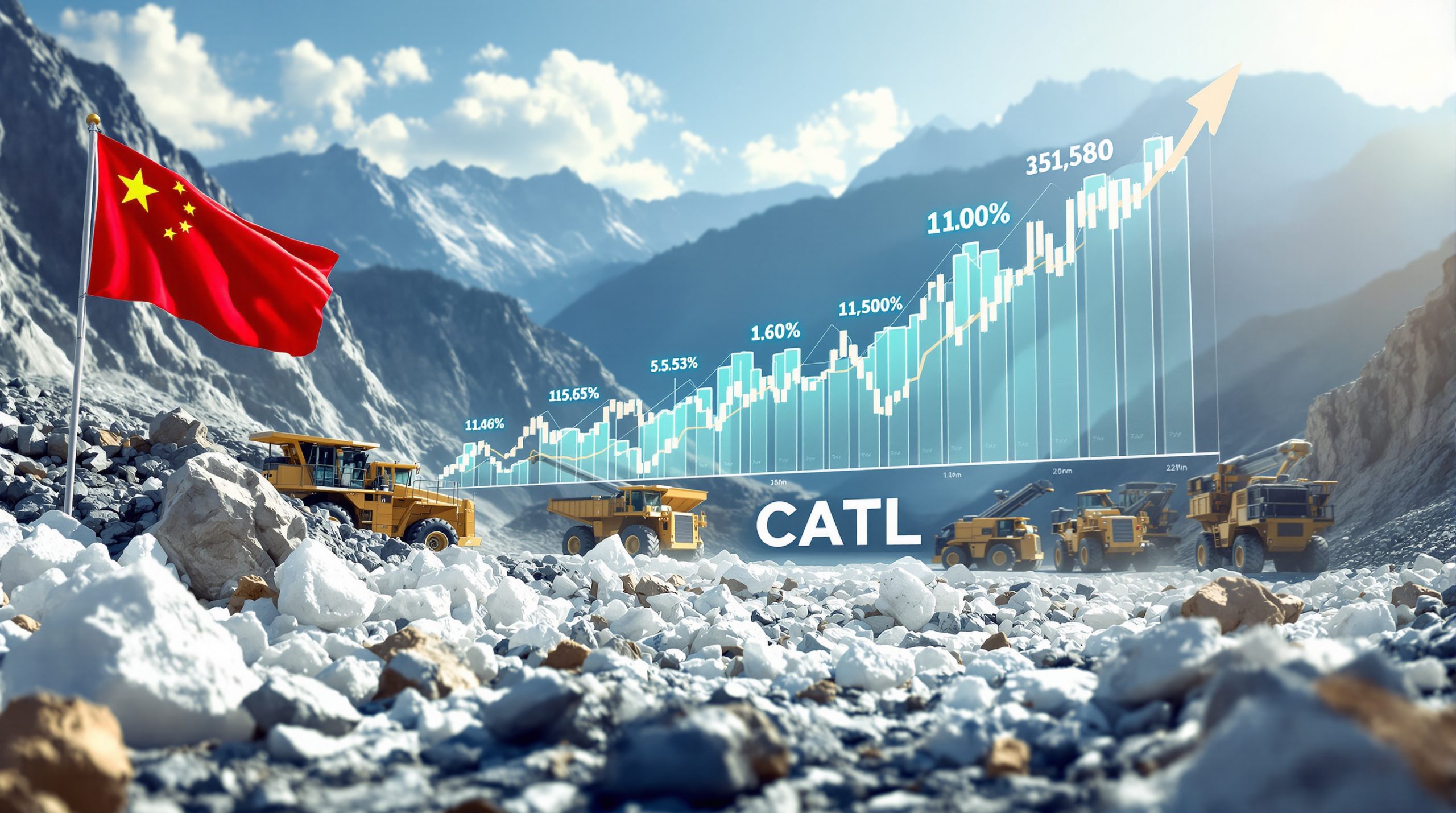What is the Goulamina Lithium Project?
The Goulamina Lithium Project stands as one of the world's largest undeveloped hard rock lithium deposits, strategically located in southern Mali, approximately 150 kilometers from the capital Bamako and 50 kilometers west of Bougouni. This world-class asset represents a significant addition to the global lithium supply chain, particularly as demand for battery materials continues to surge amid the clean energy transition.
The project sits on a massive resource base characterized by high-grade spodumene mineralization, with ore bodies extending over a substantial strike length. This geological advantage positions Goulamina among the most cost-competitive lithium operations globally.
Project Location and Significance
The project's strategic position in Mali provides access to established infrastructure while offering substantial resource potential. Located within the Bougouni-Yanfolila greenstone belt, Goulamina benefits from proximity to existing road networks and power infrastructure.
As one of Africa's most promising lithium developments, Goulamina is poised to become a cornerstone of the continent's contribution to the global battery materials market. Industry analysts believe the project could eventually represent up to 10% of global hard rock lithium supply when fully operational.
Current Ownership Structure
As of May 2024, Chinese lithium giant Ganfeng begins production at Goulamina lithium mine in Mali has acquired full ownership of the Goulamina project. This follows Australian lithium developer Leo Lithium's exit from the venture, having sold its remaining 40% interest to Ganfeng.
The transaction marked a significant shift in the project's development trajectory, consolidating control under one of the world's leading lithium producers. Ganfeng's vertical integration across the lithium value chain—from mining to battery-grade chemicals production—brings substantial technical expertise and market access to the Goulamina operation.
How Will Goulamina's Development Progress?
The Goulamina project is being implemented in a phased approach, allowing for optimized capital deployment while establishing a clear pathway to full production capacity. This staged development strategy represents an increasingly common approach in the lithium sector, balancing upfront capital requirements with market entry timing.
Two-Stage Development Strategy
Stage 1: Initial Production Phase
The first stage will establish a production capacity of 506,000 tonnes per year of spodumene concentrate. This initial phase lays the groundwork for the operation while generating early cash flow to support future expansion.
Stage 1 includes development of the primary mining area, construction of the main processing facility, and implementation of essential infrastructure. By focusing on the highest-grade portions of the deposit initially, the project can achieve rapid payback while establishing operational expertise.
Stage 2: Expansion Phase
The second stage will increase production capacity to a peak of 880,000 tonnes per year, nearly doubling the project's output and solidifying its position as a major global lithium supplier.
This expansion will leverage the infrastructure established in Stage 1, with incremental capital expenditure focused primarily on increasing processing capacity. The phased approach allows Ganfeng to align expanded production with projected growth in lithium demand, particularly from the electric vehicle sector.
Mining and Processing Methodology
Goulamina will utilize conventional open-pit mining techniques, employing industry-standard extraction methods to access the lithium-bearing ore bodies. The project's Definitive Feasibility Study (DFS) outlines a comprehensive mining plan optimized for resource recovery and operational efficiency.
The mining operation will use standard drill, blast, load, and haul methods, with minimal pre-stripping requirements due to favorable deposit geometry. With a relatively low strip ratio compared to many hard rock lithium operations, Goulamina benefits from lower waste movement costs throughout the mine life.
What Technical Specifications Define the Project?
Processing Plant Design and Capabilities
The processing facility incorporates a sophisticated flowsheet designed to maximize spodumene concentrate recovery while maintaining high product quality. Key components include:
Crushing and Grinding Circuit
- Three-stage crushing system reducing ore to a P80 of 6.2 mm
- Fine-ore bin with overflow dead stockpile for operational flexibility
- Closed-circuit ball milling and screening to a P80 of 180 μm
This configuration ensures consistent particle size distribution for downstream processing, which is critical for optimizing lithium recovery and minimizing energy consumption.
Concentration and Separation Systems
- Dual-stage magnetic separation to remove ferromagnetic contaminants
- Three-stage flotation process (roughing, cleaning, and recleaning)
- Concentrate dewatering, filtration, and storage facilities
The multi-stage flotation circuit is particularly important for achieving the high-purity specifications required by battery manufacturers, with the plant designed to produce spodumene concentrate exceeding 6% Li₂O with low impurity levels.
Water and Tailings Management
- Separate flotation and process tailings thickening systems
- Integrated tailings storage facility with environmental safeguards
- Distinct flotation and process water circuits to optimize water usage
These water management systems reflect best practices for operating in regions with variable rainfall patterns, incorporating water recycling capabilities to minimize consumption and environmental impact.
Plant Throughput and Expansion Provisions
The DFS update envisions the construction of a 2.3-million-tonne-per-year throughput plant for Stage 1. Importantly, the design incorporates infrastructure and equipment provisions for the Stage 2 expansion, which will increase plant throughput to 4 million tonnes annually.
This forward-thinking approach minimizes future capital requirements and operational disruptions during expansion. Key expansion provisions include oversized foundations for additional equipment, extra space in key processing areas, and pre-installed connection points for future modules.
What is the Project's Economic Potential?
Financial Metrics and Investment Returns
The Goulamina project demonstrates exceptional economic potential, with financial metrics that position it among the most attractive lithium developments globally:
- Pretax Net Present Value (NPV): $4 billion (at 8% discount rate)
- Internal Rate of Return (IRR): 97.8% (real)
These robust financial indicators reflect the project's competitive position on the global cost curve and its potential to generate substantial returns throughout its operational life. The exceptionally high IRR is particularly noteworthy, exceeding industry averages for lithium developments by a significant margin.
Industry Context: The average IRR for new lithium projects globally ranges between 25-45%, making Goulamina's 97.8% IRR extraordinary even among tier-one assets.
Several factors contribute to these strong economics:
- Low mining costs due to favorable strip ratio and ore body geometry
- High-grade resource enabling efficient processing
- Staged capital deployment reducing financing risks
- Expected premium pricing for high-quality concentrate products
Project Lifespan and Production Capacity
With a minimum mine life of 23 years, Goulamina offers long-term production stability in an increasingly competitive lithium market. Over this period, the project is expected to produce approximately 15.6 million tonnes of spodumene concentrate, representing a significant contribution to global lithium supply.
The extended operational timeline provides several advantages:
- Sustained cash flow generation across multiple market cycles
- Flexibility to adapt to evolving battery chemistry requirements
- Potential for resource expansion through continued exploration
- Opportunity for downstream integration as the project matures
At full production capacity, Goulamina will rank among the world's largest spodumene concentrate producers, cementing Mali's position as a key player in the global battery materials supply chain.
What Recent Developments Have Shaped the Project?
Leo Lithium's Exit and Transaction Details
In a significant development, Leo Lithium confirmed receipt of the final proceeds from selling its interest in the Goulamina project in July 2025. The transaction raised a total of $177.6 million, including:
- $171.2 million from Ganfeng Lithium Group for the Tranche 2 payment (40% stake in Mali Lithium)
- $6.4 million in interest
This second-tranche payment follows Leo Lithium's initial exit from the project in late 2023, which occurred after unsuccessful negotiations with the Mali government regarding project-related issues. The first tranche payment of $161 million was received in November 2023, from which $44.7 million in capital gains tax was deducted for payment to the Mali government.
The exit represents a significant shift in the project's ownership structure, with implications for both development timeline and strategic direction. While the specific points of contention between Leo Lithium and the Mali government were not fully disclosed, industry analysts suggest they likely involved fiscal terms, local content requirements, and development timelines.
Future Outlook and Production Timeline
With Ganfeng now fully controlling the project, Goulamina is progressing toward full production, expected to commence in 2025. The transition to a single owner may streamline decision-making and potentially accelerate development timelines.
Several key milestones remain on the path to production:
- Final engineering and procurement (ongoing)
- Site preparation and civil works (expected to commence Q3 2024)
- Major equipment installation (scheduled for Q1-Q2 2025)
- Commissioning and ramp-up (targeted for late 2025)
Ganfeng's extensive experience in lithium project development, particularly in emerging jurisdictions, positions the company well to navigate the remaining challenges. Additionally, the company's downstream processing capabilities and established customer relationships provide clear pathways to market for Goulamina's production.
Who Are the Key Partners and Service Providers?
Engineering and Technical Support
Several specialized firms are contributing their expertise to the Goulamina project:
-
Lycopodium: Responsible for the updated Definitive Feasibility Study and providing engineering, procurement, and associated project management services. Lycopodium brings extensive experience in African mining projects, having successfully delivered numerous processing plants across the continent.
-
Corica Mining Services: Engaged as the mining contractor to handle extraction operations. The company will deploy a modern fleet of mining equipment and implement state-of-the-art direct lithium extraction and blasting techniques to optimize ore recovery.
Additional technical partners include:
- Environmental consultants conducting ongoing monitoring and compliance work
- Logistics providers developing transport solutions for concentrate shipment
- Local service providers supporting site operations and maintenance
Project Contact Information
For project inquiries and media cooperation, interested parties can contact:
- Ganfeng Lithium media cooperation: Evan Sun (sunyifan@ganfenglithium.com)
How Does Goulamina Compare to Other Global Lithium Projects?
Competitive Positioning
When compared to other major lithium developments worldwide, Goulamina stands out for several reasons:
-
Resource Scale: As one of the world's largest lithium developments, Goulamina's resource base positions it as a significant player in the global market. The project's scale allows for economies that smaller operations cannot achieve.
-
Production Capacity: The planned peak production of 880,000 tonnes per year places it among the highest-capacity spodumene operations globally. This volume represents a meaningful portion of projected global lithium demand growth.
-
Economic Returns: With an IRR of 97.8%, the project offers exceptional financial returns relative to industry averages. Few lithium projects globally can match this combination of scale and profitability.
-
Development Timeline: The phased approach allows for optimized capital deployment while establishing a clear pathway to full production. This strategy mitigates market timing risks that have challenged other developments.
Compared to established operations like Australia's Greenbushes or emerging projects like the Thacker Pass lithium mine, Goulamina offers a rare combination of scale, grade, and favorable economics. Its location also provides geographic diversification for a lithium supply chain heavily concentrated in Australia, Chile, and China.
Strategic Importance for Battery Supply Chains
As electric vehicle adoption accelerates and energy storage deployments expand, Goulamina's contribution to global lithium supply takes on increased strategic importance. The project's development timeline aligns with projected growth in lithium demand, positioning it to play a crucial role in supporting the clean energy transition.
Key strategic considerations include:
- Supply Chain Diversification: Reduces dependence on traditional lithium-producing regions
- African Mining Development: Establishes a template for responsible resource development in the region
- Vertical Integration Opportunities: Potential for downstream processing facilities in the future
- EV Manufacturing Support: Helps meet critical mineral needs for the automotive industry's transformation
What Challenges and Opportunities Lie Ahead?
Operational Considerations
As with any major mining development, Goulamina faces several operational considerations that will influence its long-term success:
-
Political Stability: Operating in Mali requires navigating the country's political landscape and maintaining positive government relations. The capital gains tax situation with Leo Lithium demonstrates the importance of clear fiscal frameworks.
-
Infrastructure Development: Ensuring reliable power, water, and transportation infrastructure will be critical to operational efficiency. While existing infrastructure provides a foundation, additional investment will be required to support full-scale operations.
-
Technical Execution: Successfully implementing the complex processing flowsheet will require careful engineering and commissioning. Particular attention must be paid to achieving concentrate quality specifications consistently.
-
Market Dynamics: Adapting to evolving lithium market conditions and price fluctuations will require operational flexibility. The project's economics provide substantial buffer against price volatility, but management of production costs remains essential.
Disclaimer: The lithium market has demonstrated significant price volatility in recent years. While current economic assessments reflect conservative long-term pricing assumptions, actual project returns will depend on market conditions during operation.
Future Expansion Potential
Beyond the currently planned two-stage development, Goulamina may offer additional expansion opportunities as exploration continues and processing technologies evolve. The project's substantial resource base provides a foundation for potential future growth beyond current production targets.
Possible expansion pathways include:
- Resource extension through continued exploration of satellite deposits
- Recovery optimization via implementation of new lithium industry innovations
- Downstream integration with battery-grade lithium refining facilities
- By-product recovery of other valuable minerals present in the ore body
These opportunities could further enhance the project's value proposition and extend its operational life beyond the currently projected 23 years.
Conclusion: Goulamina's Role in the Global Lithium Landscape
The Goulamina Lithium Project represents a significant addition to global lithium supply at a time when battery material demand continues to accelerate. With its exceptional resource base, phased development approach, and robust economics, the project is well-positioned to become a cornerstone of the lithium supply chain.
As Ganfeng Lithium advances the project toward full production in 2025, Goulamina will contribute to diversifying global lithium sources while establishing Mali as an important player in the battery materials sector. The project's development will be closely watched by industry observers as a barometer for large-scale lithium investments in emerging mining jurisdictions.
The project highlights several important trends in the lithium industry:
- The shift toward developing resources in new geographies to meet growing demand
- The importance of phased development approaches to manage capital requirements
- The value of vertical integration across the battery materials supply chain
- The critical role of technical expertise in delivering successful lithium operations
For Mali, Goulamina represents an opportunity to participate in the global energy transition while attracting foreign investment and developing technical capabilities. The success of this project could serve as a catalyst for further resource development throughout the region, potentially creating new opportunities similar to Argentina lithium brine insights in other parts of Africa.
As the global push toward electrification continues, projects like Goulamina will play an increasingly vital role in enabling the clean energy transition. With battery demand projected to grow exponentially over the coming decades, securing sustainable and ethical sources of lithium remains a priority for manufacturers and governments alike.
Want to Profit from the Next Major Mineral Discovery?
Discovery Alert's proprietary Discovery IQ model delivers instant notifications on significant ASX mineral discoveries, helping you identify investment opportunities before the broader market. Explore why major mineral discoveries can lead to exceptional returns by visiting the Discovery Alert discoveries page and position yourself to capitalise on the next Goulamina-scale lithium project.




